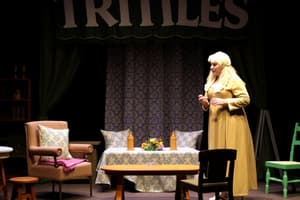Podcast
Questions and Answers
Which of the following best describes a hand held prop?
Which of the following best describes a hand held prop?
- A prop carried by an actor during a performance (correct)
- A prop that does not interact with the actors
- A prop designed for background scenery
- A prop that is permanently affixed to the set
What is NOT a responsibility of the props designer?
What is NOT a responsibility of the props designer?
- Create a props list
- Construct the set entirely (correct)
- Supervise props during production
- Store props appropriately
Which of the following types of props gives information about a character?
Which of the following types of props gives information about a character?
- Personal props (correct)
- Set props
- Hand held props
- Background props
Why is a props list considered essential in theatre production?
Why is a props list considered essential in theatre production?
What kind of prop is typically used to provide context for the setting in a scene?
What kind of prop is typically used to provide context for the setting in a scene?
Which of the following statements about props is TRUE?
Which of the following statements about props is TRUE?
What is an example of a personal prop?
What is an example of a personal prop?
What is the primary function of costumes in establishing mood and atmosphere in a scene?
What is the primary function of costumes in establishing mood and atmosphere in a scene?
Which category of props includes items that are both functional and handled by actors?
Which category of props includes items that are both functional and handled by actors?
What is a key consideration for a props designer when selecting items for a production?
What is a key consideration for a props designer when selecting items for a production?
Why is costume quality important in a theatrical production?
Why is costume quality important in a theatrical production?
In which scenario would a props list be considered essential?
In which scenario would a props list be considered essential?
What is a potential effect of using lanterns in a stage production on costumes?
What is a potential effect of using lanterns in a stage production on costumes?
What is the main advantage of a thrust stage compared to an end-on stage?
What is the main advantage of a thrust stage compared to an end-on stage?
What unique characteristic does a traverse stage have?
What unique characteristic does a traverse stage have?
Which type of staging provides the most intimacy for the audience?
Which type of staging provides the most intimacy for the audience?
Which of the following is NOT a primary responsibility of a set designer?
Which of the following is NOT a primary responsibility of a set designer?
What is a critical consideration for a promenade performance?
What is a critical consideration for a promenade performance?
What is the impact of blocking on the audience's experience?
What is the impact of blocking on the audience's experience?
Which aspect of set design might be influenced by a specific historical period?
Which aspect of set design might be influenced by a specific historical period?
What type of set might best suit a performance with frequent changes of location?
What type of set might best suit a performance with frequent changes of location?
Flashcards are hidden until you start studying
Study Notes
Props in Theatre
- Props are items used on stage, either by actors or as part of the set.
- Props can be functional, like a working torch, or non-functional, like a lamp.
- Props are categorized into three types: hand-held, set, and personal.
- Hand-held props are used by actors, like a gun or a letter.
- Set props are placed on the stage, such as furniture or a vase.
- Personal props are specific to characters, like jewelry or a wallet.
Props Designer Responsibilities
- The props designer creates a list of props needed for a production.
- Props are collected and organized based on scenes.
- The designer ensures props are stored safely and are ready for use.
- The designer supervises the use of props on stage, providing actors with items as needed.
- The designer is responsible for collecting and returning props after performances.
Importance of Props in Theatre
- Props enhance realism by making on-stage actions more believable.
- Props provide context about the setting, time period, and characters.
- Props can build or change the mood and atmosphere of a performance.
Types of Stage Design
- End-on staging is the most common. The audience sits in front of the stage, making it straightforward for blocking and sightlines.
- Thrust/Apron staging extends the stage, allowing the audience to be seated around three sides. This creates a sense of involvement and intimacy.
- Traverse/Avenue staging positions the audience on either side of the stage, facing each other. It's often used for catwalks and creates close proximity and intimate atmosphere.
- Theatre in the round places the audience around all sides of the acting area. This enhances intimacy and audience engagement but requires careful blocking.
- Promenade staging involves the audience moving from stage to stage, often within a larger space or multiple sites. Highly intimate and participatory but may require accessibility considerations.
Set Designer Responsibilities
- Read the script and note the location of each scene.
- Note stage directions regarding entrances and exits.
- Conduct research to understand the time period and style of the play.
- Create a ground plan for each scene.
- Source materials and build set pieces.
- Practice set changes during rehearsals and adjust as needed.
- Strike the set after each performance.
Studying That Suits You
Use AI to generate personalized quizzes and flashcards to suit your learning preferences.




